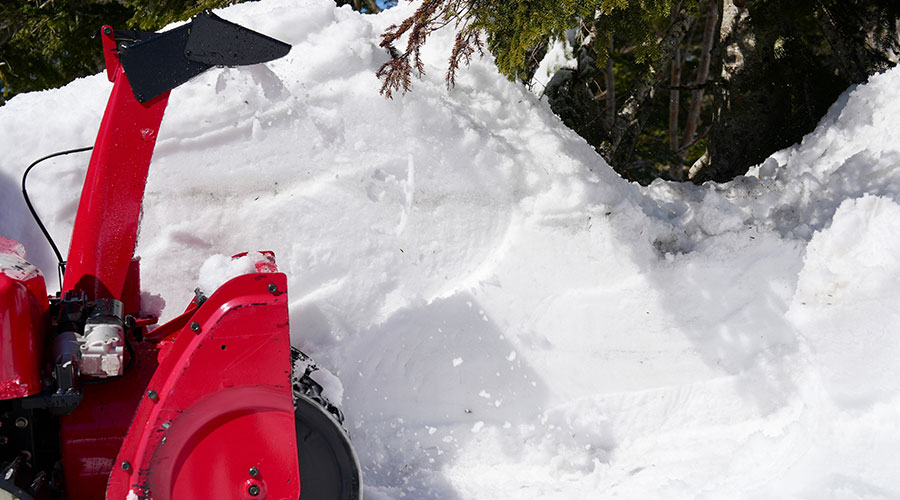Targeting Ice and Snow
Traditional chemical application, combined with two new preventive methods of ice and snow melting, can keep paved areas clear and safer
With winter just around the corner, grounds managers must quickly firm up plans for snow and ice management. One major component to keeping property safe for vehicles and pedestrians during winter months is the use of ice-melting agents. A closer look at available ice-melting chemicals, their specification and application, and strategies for maximizing effectiveness without waste and damage to the surrounding environment will help managers make better decisions.
Traditional ice management consists of applying deicing agents, followed by snow removal. Today, new products and technology make preventive treatments to inhibit ice formation possible. Deicing products melt through ice, while anti-icing products keep snow and ice from forming or sticking to pavement, making removal easier. Some products can handle both anti-icing and de-icing functions.
Chlorides
Rock salt, or sodium chloride, is the most commonly used ice melter and is relatively inexpensive. Rock salt melts ice at temperatures above 20 degrees. It does not chemically attack concrete but is corrosive to rebar and steel. In high concentrations, sodium chloride can be toxic to vegetation and can build up in soil, causing permanent damage.
Potassium chloride and urea are common fertilizers often perceived as safe around vegetation, but at high concentrations, they can be deadly to plants and contaminate water. Urea contains no chlorides, so it is less corrosive and safer to use on concrete with rebar. Urea is effective down to 15 degrees and potassium chloride to 12 degrees. Potassium chloride and urea work more slowly than calcium chloride and leave a slight white residue.
Calcium chloride is liquid in its natural form and is converted into a dry material. It absorbs moisture from the atmosphere, while rock salt, potassium chloride and urea must come in direct contact with moisture. When calcium chloride returns to liquid, it emits heat, while rock salt, potassium chloride and urea need heat to work. Calcium chloride melts ice down to -25 degrees.
A new corrosion-inhibited grade of liquid calcium chloride can produce 80-90 percent less corrosion than sodium chloride. Other advantages of this new corrosion-inhibited calcium chloride are its ability to cut through snow and ice more quickly than salt or magnesium chloride, its lack of sediment problems in tanks, and easier clean-up of vehicles.
Finally, magnesium chloride is similar to calcium chloride. It is considered less corrosive, safer on concrete and less damaging to vegetation, animals and humans, and it tracks less than calcium chloride. The main drawback of magnesium chloride is that it is only 48 percent active and must be applied at a higher rate than calcium chloride. Magnesium chloride melts ice at temperatures to 5 degrees.
Acetates
Sodium acetate and calcium magnesium acetate (CMA) are dry formulations used as ice melters on bridges and parking decks. They are considered non-corrosive and are biodegradable, creating no problems in runoff water. They change ice and snow into a slushy texture, making them less desirable for use on walkways. Sodium acetate and CMA are effective to 0-5 degrees.
CMA is used as a corrosion inhibitor, is blended with road salt and generally is used in a solid form and spread on the surface. CMA is also available in liquid form and generally is used for preventing ice on roads, bridges and parking structures. CMA is biodegradable and has a residual effect, requiring fewer applications.
Potassium acetate is a liquid deicer that contains no chlorides. It is less harmful to structural steel and reinforcing steel embedded in concrete. It readily biodegrades and has little environmental impact. Potassium acetate is effective to -15 degrees. It is a clear liquid and requires no agitation, and it has a residual effect, requiring fewer applications.
What to Use and When
Managers choosing ice melting products should consider the characteristics that are most important for a particular location.
The main reason for using ice-melting products is safety. Reducing or inhibiting ice accumulations a fast as possible to maintain a safe environment for pedestrians and vehicles.
Different areas have different priorities. Bridges or areas near exposed steel might require non-corrosive materials. Areas around environmentally sensitive sites deserve non-chloride and biodegradable products. Near building entrances, fast acting-chemicals and easy cleanup might be priorities.
Weather conditions also play a vital role in deciding which product to use and when to apply it. In extremely cold weather, rock salt will be least effective. And while managers cannot predict the weather, they can base decisions for pre-season purchasing on historical data. Decisions regarding timing of applications are not as easy, however. Monitoring weather forecasts, along with luck, play important roles in timing applications.
Managers also should consider the need for speed. In general, liquid formulations are fastest acting followed by spherical pellets that cut vertically through snow and ice, allowing the “brine” to reach the pavement faster.
Cost also is an inevitable consideration. Some products might seem more expensive, but in the long run, benefits such as less product applied, smaller inventory, a fraction of the storage space and fewer applications might more than make up the cost difference.
All of these traits also can translate into reduced labor. With today’s high price of fuel , managers must remember to add shipping costs into the equation. Also, the cost of damage to expensive equipment, infrastructure and environment must figure into budget calculations. The price of the product might seem high, but what is the price for failing to use the right product?
Consider damaging affects of products. Choose products that are appropriate for the situation, for example non-corrosive (non chloride) products for use on bridges and other structures with exposed steel. Know that all products could have damaging effects if used at improper rates. Improper application rate is probably the number one cause of damage not the use of the product itself.
Check availability of products in your area and the packaging options. Will you purchase in bulk, tote or bag or gallon jugs? Is the product readily available and nearby or will you have to maintain a large inventory to meet the possible demand? Choosing products that are produced in your region will likely be most readily available and cost effective.
Preventive Strategies
Two relatively new practices — pre-wetting and pretreatment — can help managers increase efficiency and effectiveness of salting operations.
In Canada and many parts of the United States, crews are using so-called pre-wetted salt. This practice involves adding a small amount of liquid de-icier or salt brine to road salt as it is placed on the road. Pre-wetted salt stays on the road better and works faster than dry salt.
Pre-wetting also reduces bounce and blowing of pellets or crystals. The city of River Falls, Wis., reports an estimated reduction in application rates of 20-30 percent using this strategy because salt stays in place.
Pretreating, or applying products before winter precipitation, also is becoming more common. Pretreating can eliminate, or at least decrease, the need for ice or snow removal operations. Also, pretreating can inhibit ice and snow from sticking to the pavement and saves time in snow removal operations, should they become necessary.
The best way to maximize efficiency and effectiveness of a salting program is to develop a written game plan. Managers can determine ahead of time the routes, the people responsible for the routes, the products, and the equipment that will be used, as well as the circumstances under which they will be used.
Managers also should consider providing equipment that is in good working order and calibrated so that operators apply the proper amount of product. Adequate, covered storage for products is also important to cost-effective, environmentally conscious ice management.
If a plan is in place and followed and all staff receives proper training, road and walk ways will be safer, workers will use fewer chemicals, time will be saved, equipment, buildings and roads will require fewer repairs, and landscaping and surrounding environment will incur minimal damage.
Related Topics:











